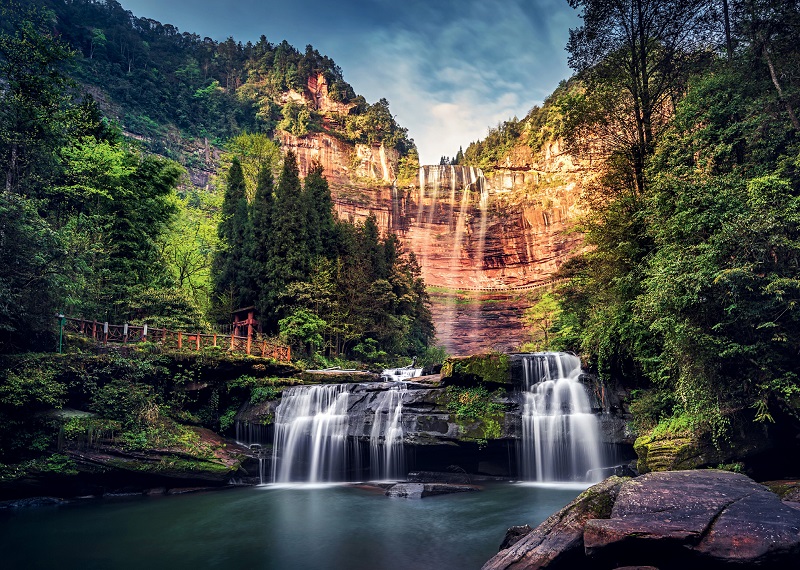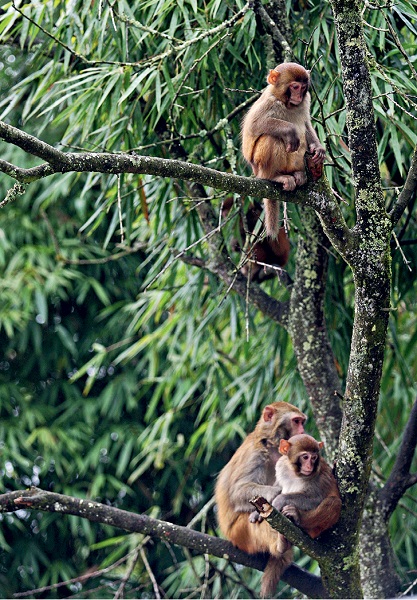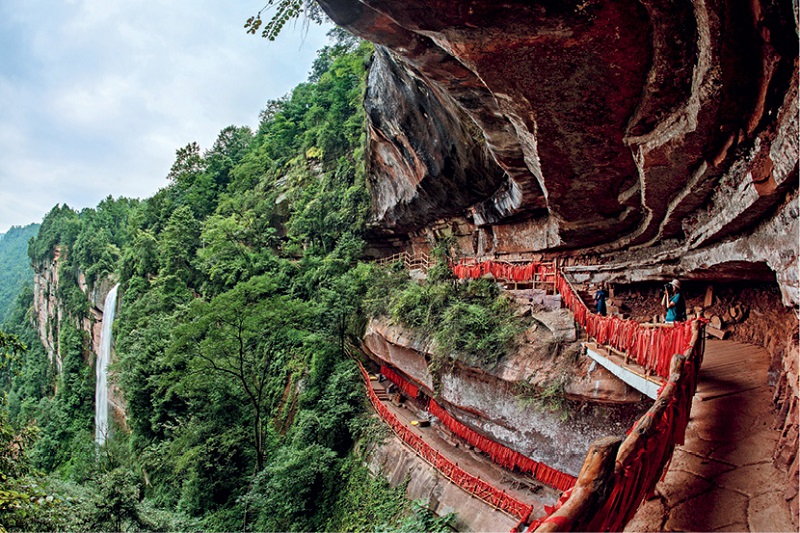The Simian Mountains Scenic Area sits in the southern Jiangjin District of Chongqing in southwest China, 128 kilometers away from downtown Chongqing. It is a part of the Dalou Mountain Ranges on the Yunnan-Guizhou Plateau.
Covering an area of 213 square kilometers, it is a national forest park and 5A-rated national tourist attraction. The park consists of the Wangxiang Pavilion, the Shuikou Temple and 130 scenic spots distributed throughout six sub-scenic areas. With a forest coverage rate of 95.14 percent, this area also boasts the largest and best-preserved subtropical evergreen broadleaf forest at the latitude. The highest point of the park is Wugongba, at an altitude of 1,709.4 meters. The average annual temperature is around 13.7 degrees Celsius, while the temperature from July to September in the summer time ranges between 22 and 25 degrees Celsius. The environment is very suitable for enjoying summer vacations and leisure activities.
The park is home to more than 6,000 kinds of flora and fauna, including the Dipteris chinensis Christ, which is as old as dinosaurs, and the Cyathea among other plants under first-class state protection. There are also dozens of rare plants under state protection, such as the ginkgo, Emmenopterys henryi Oliv. and Chinese yews, and 23 species of rare animals that are under state protection, such as the clouded leopard, macaque, and large and small Indian civet.
The Simian Mountains are known as the “home of a thousand waterfalls” including the Wangxiang Pavilion Waterfall, Shuikou Temple Waterfall, and 1,000 other waterfalls. One of the most spectacular waterfalls is the 38-meter-wide Wangxiang Pavilion Waterfall, falling from a height of about 152 meters. It has been called “the first high waterfall in China,” being more than twice as high as the well-known Huangguoshu Waterfall in Guizhou.

The Simian Mountains, a picturisque postcard image of tranquility.
Wangxiang Pavilion
The Wangxiang Pavilion is the most popular scenic site in the Simian Mountains Scenic Area, and its most famous scenic spot is the Wangxiang Pavilion Waterfall. Following the walkway, tourists first come to an attraction called the “Big Eye,” which is a natural cave at the middle of a rock formed by the force of weathering. It is typical of Danxia landscape and got its name as it is shaped like an eye. Temperatures inside the “Big Eye” are warm in winter and cool in summer, making it an ideal place to escape the summer heat. After rainfall, a few small waterfalls begin flowing down in front of the cave.
Standing in the middle of the “eye,” you can see the waterfall very clearly from afar. From the “Big Eye,” visitors can also see the “Big Heart,” the heart shape formed by Danxia rocks surrounding the Wangxiang Pavilion Waterfall. The Wangxiang Pavilion Waterfall, which flows through the center of the “heart,” looks like Cupid’s arrow.
After climbing up past the “Big Eye” and strolling on to the waterfall, visitors arrive at a platform where a rainbow can often be seen hanging in front of the waterfall in the morning. To the right of the platform is a wooden bridge, and behind the bridge is a winding boardwalk guiding visitors to the foot of the waterfalls where they can get a close-up view. Here the waterfalls cascade straight down in front of the eyes, making a mist and creating booming sounds.
Recently, the Wangxiang Pavilion scenic site opened a new night tour route which consists of 11 light displays, such as a laser show, digital screen space, and illuminated forest. At night, the Wangxiang Pavilion presents an even more fantastic and mysterious atmosphere with the colorful lights.

Monkeys can often be spotted playing on trees in the Simian Mountain Scenic Area.
The Shuikou Temple
Different from the Wangxiang Pavilion Waterfall, the Shuikou Temple Waterfall is noted for its unique shape and cultural meanings. The waterfall is 94.18 meters high, swirling down from the top. This waterfall can be viewed from several different angles.
One angle is to follow a trail that leads up along the cliff to behind the water curtain. When looking at the waterfall with a width of nine to 17 meters, visitors can see water that has expanded to more than 30 meters in the width after falling halfway down the rock.
Another angle is from the valley. When looking up at the sky after walking down the 818 stone steps to the valley, the sky appears like a patch, and the waterfall falling from its high elevation appears like a towering column of water embedded in the rock. The roaring sound and mist of water in the air transport visitors into another mysterious world.
The Shuikou Temple Waterfall is located in a round-shape valley, and its lowest point is a water outlet. In the event of a heavy rainfall or flooding, the water inside the valley is discharged from the outlet. As a result, locals call this place “Shuikou,” which literally means “water outlet.”

A visitor is taking a photo of the stunning views in the Simian Mountain Scenic Area.
Rock Engravings, Stone Stairway, and Wooden Bridges
In addition to its natural beauty, the Simian Mountains boast a number of cultural attractions. There are ancient rock engravings that date back 4,000 to 5,000 years. The engravings were made on a cliff 2,000 meters east of Hongdong Village, with a creek flowing by, a highway to the southeast, crop fields to the west, and forests in the north.
The images are displayed on a stone wall which is 163 meters long and eight meters high. Across an area of about 160 square meters, animal images, such as those of cows, bears, fish, goats, are depicted clearly. The animals are etched in various sizes, the largest is a bull’s head three meters long and two meters high. Some animal figures are complete while some are depicted only partially. There are around 40 recognizable animal images. The composition and vivid images portrayed with distinct lines present a kind of ancient and simple natural beauty.
There are also many inscriptions left by later generations in tribute to this work of art, the earliest of which was made in 1638 during the reign of Emperor Chongzhen of the Ming Dynasty.
Archaeological evidence shows that primitive people during the late Neolithic period risked their lives to create these giant engravings on the cliffs with just polished tools made of stone and bones.
In the Zhongshan ancient town located in the scenic area, there is a stone staircase with more than 6,000 steps, famous for the love story of two elderly people, Liu Guojiang and Xu Chaoqing. Back in the 1950s, Liu fell in love with Xu, a widow who was 10 years older. In order to avoid rumors, they eloped and settled down in the mountains. To ensure Xu could move around safely and easily, Liu Guojiang spent his life chiseling the stone staircase along the cliffs. On his death, the staircase had more than 6,000 steps, and became known as the “Love Staircase.” This touching story has been adapted into TV series and a movie.
Another object of historical significance in the Dahonghai scenic site is the “Red Army Bridge.” In January 1935, after the Red Army retreated from the Battle of Tucheng, the wounded were brought to the Simian Mountains, which are 15 km away from Tucheng Township, to recuperate. At that time, a farmer and his son surnamed Tang from Honghai Village risked their lives to rescue seven wounded soldiers. Before leaving after recovery, the soldiers built a wooden bridge to express their gratitude to the villagers. After that, the locals did not need to wade through water any more to get out of the village. After the War of Liberation from 1946 to 1950, the bridge was named the Red Army Bridge.
The Simian Mountains present stunning landscapes of waterfalls, hills, forests, and rivers, and also serve as a witness to the life and culture of local residents.